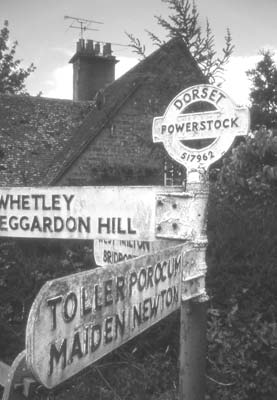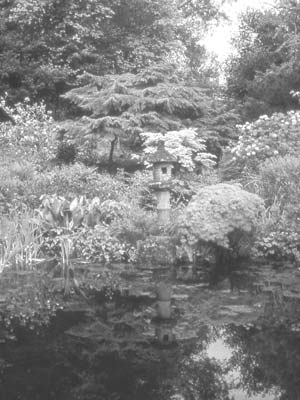Garden gawking — walking through the English countryside
by Yvonne Michie Horn, Santa Rosa, CA
“Did you put a little something in the box?” Lord Bigby asked.
He’d met us on the lawn in front of Minterne Manor, where first the Churchill family and then the Bigby family have lived for 350 years. Below lay Minterne Gardens, abundant in century-old rhododendrons and azaleas, ancient cedars, waterfalls and ponds.
Like others wrestling with the upkeep of grand houses and gardens, Lord Bigby counts on “a little something in the box” — in this case, three pounds a person, please — when it comes to replacing tiles on a 2-acre roof and weeding a mile of garden. Three pounds seemed barely a drop in the bucket.
The tour
It was day four on a week-long trek through what The Wayfarers’ wish book of walking journeys calls “Dorset Gardens: Rambles and Roses.” The Wayfarers, a U.K. touring company, are old hands at popping into their neighbors’ yards; they’ve been leading tours through the English countryside and beyond for 21 years.
On this May ’03 itinerary, we would visit a total of 14 gardens, sneaking up on them via wildflower-bordered lanes, shortcuts through farmyards inhabited by curious cows, footpaths through waist-high fields of yellow rape and trails through shady beech forests carpeted with bluebells.
Reflecting the worldwide downturn of tourism, there were but six of us, hailing equally from the east and west coasts of the United States, half the expected usual number. Yet another reflection was that Michael West, Wayfarers’ founder, served as our “walk manager,” maneuvering the support van around the countryside to show up, just at the needed moment, with a van fall of drinks and nibbles and the offer to give anyone with boot fatigue a lift.
Geoffrey Newman, a Wayfarers guide for a dozen years, with measured tread and engaging charm led us from garden to garden. As we walked, he filled us in on the property ahead, elaborating on the history and plantings, sometimes revealing gossipy details about its owners and once stopping to read an apt passage from “Tess d’Ubervilles” (for this was indeed Thomas Hardy country), all leading up to an almost whispered conspiratorial “Let’s go see” as we arrived at the garden’s gate.
It was only at the end of the trip, when Geoffrey mentioned that he was restoring his own family’s historic garden, that I learned we’d been traipsing after Sir Geoffrey Newman.
We met at Fairweather Farms Hotel, a country inn centrally located to the first half of our excursions that could well qualify as garden number 15 for its mature plantings on terraced acreage overlooking sheep-dotted pastures and the village of Hawkesbury below.
Halfway through the trek we moved to Bridge House Hotel, a gracious hostelry dating from the 13th century on the main street of Beaminster, an old market town surrounded by the countryside through which we’d walk for the balance of the week.
Our walks took us from stately homes to simple cottages, from impeccably manicured grounds to proudly cultivated tiny plots. Simple or grand, all showcased the English love of gardening.
Fine gardens
Mr. Derek Andrewes, “going on 40 years planting this property,” walked us through his woodland garden that began as a small thought in a hidden valley and grew into four acres covering the better part of a hill.
“It’s a wanderer’s garden,” he told us, “all shrubs and trees and bird song.”
Pausing by a vine with pretty flowers, he commented that he’d planted it so long ago that he couldn’t remember what it was. “But it’s happy as Harry climbing that tree!”
By contrast, noted garden writer and designer Penelope Hobhouse’s garden had the feel of an enclave, a safe haven enclosed by evergreen walls.
“I’m not so interested in color schemes now,” she told us as she took us about the one-acre garden that embraces the restored coach house where she lives. “At 73, I’m not getting any younger. Shrubs are far easier to take care of than flowers.”
One garden we visited was planted with grandchildren in mind, abundant in nooks and crannies perfect for hide-and-seek. Another took in distant views of the English Channel from sweeps of terraces, brilliant with terra-cotta-colored azaleas, below what was once a 1930s-era hunting lodge.
Wayford Manor’s 13th-century garden, redesigned by noted landscaper Harold Petos in 1902, featured terraces and loggias worthy of a performance of “Romeo and Juliet.”
Nancy Lady Henley’s garden, in the churchyard of the renovated Congregational church where she lives, was composed of simple rectangular beds abundant in annuals and perennials not yet in full flower.
“You can tell who does their own gardening,” one of our group commented. “They’re the ones who bend down when they spot a weed and pull it up.” As did Lady Henley.
A special place
One of my favorite gardens was that at Melpash Court where flower beds and shrubs hug the house’s Jacobean splendor before expanding into lawns and acres of formal gardens. Head gardener Timothy Lewis took us about after first filling us in on Melpash’s history from notes he’d made that morning on a torn-apart Kellogg’s cereal box.
“We believe in recycling here,” he said. And well they should, for over 60 tons of compost is produced by the gardens each year.
We toured Melpash Court in drizzle, with Geoffrey cheerfully reminding us that landscapes wrapped in mist can be memorably beautiful and that a little rain never hurt anyone. “Wrapped in mist” turned to downpour as we approached Slope Manor, built in the 17th century as an ecclesiastical court house and now owned by Mr. and Mrs. Anthony Hichens.
Mrs. Hichens answered Goeffrey’s knock, took note of the soggy gathering on her doorstep and insisted that we come in, shed our boots and view the garden’s display of camellias, rhododendrons and azaleas from inside the house. Tea arrived to be sipped in a library addition to the house designed by Thomas Hardy, who enjoyed equal success as both an architect and writer.
Gardens for all reasons
Breakfasts and dinners were eaten at the inns where we stayed. Lunchtimes found us at village pubs, with one memorable exception: a picnic laid out by Michael that included sandwiches of sliced salmon, chicken brochettes and plentiful crudités plus a finale of lighter-than-air meringues filled with whipped cream and strawberries.
Our tour of the gardens at Mapperton Manor, home of the Earl of Sandwich, with its elaborate Italianate garden set deep among unspoiled hills, ended with a traditional cream tea, described by Michael as “something no one eats for health reasons.” (Cream teas, along with a little something in the box, help keep the Earl of Sandwich’s 16th-century roof in repair.)
By week’s end, traipsing after Geoffrey, we had walked through fields of cowslips and on lanes bordered with froths of wild garlic to an amazing diversity of gardens — gardens designed to reflect power and wealth, gardens that symbolized utopia, gardens based on a mythological idea, gardens created for no other reason than a desire to work the earth and make something beautiful, kitchen gardens trimmed neatly with tiny box hedges and cottage gardens crammed house to garden gate with abundant flowers — each different, each reflecting the English love of gardening.
“Let’s go see!” And with The Wayfarers, we did.
Traveling with The Wayfarers
The Wayfarers currently offer “Roses and Rambles in Devon and Dorset,” with walks taking place May 9-15 and June 27-July 3 in 2004. The cost is $2,695, a price inclusive of all lodging and meals.
Participants can expect easy walks of four to six miles a day on country lanes and pathways to reach the gardens. Terrain includes riverbanks, valleys, gentle hills and the gardens.
Dates for my trek coincided with that of the annual Chelsea Flower Show in London (see box on page 46) so that participants could attend, if they wished, at their own expense.
In addition to the Dorset ramble, The Wayfarers lead walkers along pathways throughout the United Kingdom, Europe, the Pacific Rim and North America. For further information, call 800/249-4620 or visit www.thewayfarers.com.
Yvonne Horn, as a guest of The Wayfarers, received a discount on the published land tour price; all airfare and fees in London were paid by the author.



